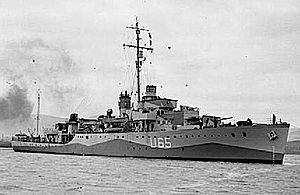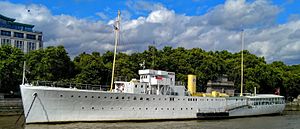HQS Wellington facts for kids

Wellington as she is today from across the Thames.
|
|
Quick facts for kids History |
|
|---|---|
| Name | HMS Wellington |
| Builder | Devonport |
| Launched | 1934 |
| Out of service | 1947 |
| Identification | Pennant number: U65 |
| Fate | Sold as headquarters ship |
| Name | HQS Wellington |
| Owner | Honourable Company of Master Mariners |
| Acquired | 1947 |
| Status | Headquarters ship on River Thames |
| General characteristics (World War II) | |
| Displacement |
|
| Length | 266 ft 3 in (81.15 m) o/a |
| Beam | 36 ft (11.0 m) |
| Draught | RN ships : 9 ft 11 in (3.02 m) – 10 ft 1 in (3.07 m) |
| Propulsion |
|
| Speed | 16.5 knots (19.0 mph; 30.6 km/h) |
| Complement | 100 |
| Armament |
|
HQS Wellington is a historic ship that was launched in 1934. She started her life as HMS Wellington, a Grimsby-class for the Royal Navy. During World War II, she helped protect other ships in the Atlantic Ocean.
Today, she is known as HQS Wellington. She is now docked in London, England, on the River Thames. She serves as the main office for the Honourable Company of Master Mariners. This group of expert sailors always wanted a special place to meet.
After World War II, it was hard to build a new meeting hall in the city. So, in 1947, the Royal Navy offered the Wellington for sale. The company bought her and turned her into a floating hall. It was a perfect home for a group of people who love the sea.
Since 2014, Wellington has also been the London address for the Flag Institute.
Ship's Story
HMS Wellington was built in Devonport in 1934. Before World War II, she sailed in the Pacific Ocean. She spent time in New Zealand and China.
When she was built, Wellington had two 4.7-inch guns and one 3-inch gun. She also had anti-aircraft guns to protect herself from planes. She carried depth charges to fight against enemy submarines.
During World War II, Wellington mainly helped protect convoys of ships. These convoys carried important supplies across the Atlantic Ocean. She helped destroy an enemy U-boat (submarine). She also took part in Operation Cycle, which was an evacuation of Allied soldiers from Le Havre.
In 1943, Captain John Treasure Jones briefly commanded her. He later became the last captain of the famous RMS Queen Mary ocean liner.
The Grimsby-class sloops, like HMS Wellington, were important ships. They were designed to hunt submarines. They led to the design of the Black Swan class ships built later.
Another historic ship, HMS President, was once docked near Wellington. This ship was built in 1918 as HMS Saxifrage. She was a special anti-submarine ship from World War I. She is one of the last three Royal Navy warships still around from that war.
Life After the War
After World War II, HMS Wellington was changed from a warship into a headquarters ship. This work was done at Chatham Dockyard. Many groups and companies helped pay for this transformation.
One special addition was a grand wooden staircase. It came from an old Isle of Man ferry called SS Viper. That ferry was being taken apart at the same time. Wellington arrived at her new home on the Victoria Embankment in December 1948. She has been the floating hall for the Honourable Company of Master Mariners ever since.
In 1991, HQS Wellington went into dry-dock for three months. This was for major repairs and updates. Workers fixed steel parts and painted the outside. Inside, they updated the bathrooms, offices, and living areas. New carpets were added. The ship now displays the company's marine paintings, old maps, and ship models.
Images for kids






